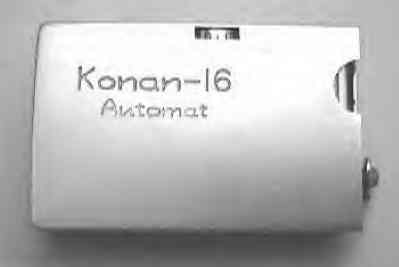

KONAN SUBMINIATURES
The Konan 16 Automat arrived on the scene in 1950, soon after the patents for the camera were bought by Chiyoda (later, Minolta) which saw the potential in the creative design. In fact, while the original Konan camera -- called the Mica Automat was designed by the Konan Optical Institute, it was produced by Chiyoda!
The Konan cassette was a two-lobed, metal design with a spring-loaded trap door in the front to expose the film. This allowed cassette changes mid-roll -- very unique. When Chiyoda took over, they redesigned the cassette for use in their later Minolta cameras. The trap door was gone and so was the mid-roll interchangeability.
(1950) -- 25mm (f3.5-16); T, B, 1/25-1/200. This model was a modified version of the Mica Automat. It had a modified lens and shutter, using a longer 25mm lens now marked "ROKKOR", and the addition of a T shutter setting. The lens is still fixed-focus, but slip-on filters, and even a close-up lens were available. It was available in chrome, with a smooth or a waffled exterior. Some were marked "MADE IN OCCUPIED JAPAN". At the time, Konan Optical had run out of funds, and the patents to the original camera -- the Mica Automat -- were sold to Chiyoda Optical (the original name of Minolta). This camera was made by Chiyoda, the early name for Minolta.
(1950) -- 25mm (f3.5-16); T, B, 1/25-1/200. An improved version in that it had flash synch. In all other respects it was the same camera. This camera was made by Chiyoda, the early name for Minolta.
(1950) -- 25mm (f3.5-16); T, B, 1/25-1/200. A black police version. This camera was made by Chiyoda, the early name for Minolta.
(1952) -- twin 25mm (f3.5-16) lenses. Twin shutters of T, B, 1/25-1/200. This is a rare stereo version of the Konan 16 Automat. Only a few were made -- all by hand. It used two cassettes at once. This camera was made by Chiyoda, the early name for Minolta.
(1955) -- 25mm (f3.5-16); B, 1/25-1/200. An improved model, but also the last Konan model. On all previous Konan and Minolta models, the shutter speed and aperture setting dials were on the top of the camera -- right next to the shutter release. One advantage of this setup is that the dials were covered when the camera was closed. But perhaps the designers felt that it was too easy to unintentionally move the dials when trying to press the shutter release button. Another reason to move the dials to the side of the camera was to facilitate exposure settings without opening the camera. This would be an advantage since opening the camera meant advancing the film. For whatever reason, on this model both dials were moved to the side of the camera. The shutter release was kept on the top. This was probably just a prototype, as Minolta started to take over all of the future designing -- and worked on a newer model called the Minolta 16 Automat (which was also apparently just a prototype).

To return to the main index for the Sub Club click here.
COPYRIGHT @ 1995-2024 by Joe McGloin. All Rights Reserved.